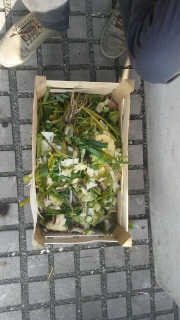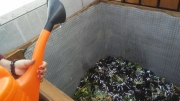If you have been thinking about making compost but wondering it may be too difficult, smelly or undoable in your garden, you should visit CEU Edible Rooftop Garden, located on the rooftop of Nador 15 building. Over there, The Sustainable CEU Action Team have placed two boxes to produce home-made compost. They aim to create a closed cycle garden which would limit the need to bring in compost or other nutrients from outside.
But first, what do we refer to when we talk about compost? Compost is simply organic material that can be added to soil to help plants grow and it is done by the decomposition and recombination of plant and animal life. Although there are different ways in nature to produce compost, home-made compost is mainly composed of kitchen food waste and could contain grass, wood, leaves, natural fiber clothes, hair and bones, tea leaves, and coffee grounds. Compost help to maintain a healthy soil in an environmentally sustainable matter. It provides a vast range of elements that help the plants to grow such as nitrogen, carbon, calcium, oxygen, iron, phosphorus and it’s a great source of food for micro biotic life. It improves structure and texture of the soil providing good aeration, water retention and resilience to erosion. Additionally, it improves the pH buffer and it’s a natural soil toxin neutralizer.
The location of the pile (hidden behind an elegant wood fence but near the garden) has been chosen taken into account the required conditions for the composting process. The compost should not be directly expose to the sun and it should be kept moisty to ensure optimal activity of the microorganisms which break down the organic matter. Additionally, the pile is covered with a piece of carpet to keep the heat inside and prevent it from dryness in summer or wetness in winter while still allowing the mixture to breathe.
The is filled with different layers of organic matter. Compost includes a green layer– which is a great source of nitrogen – from the kitchen food waste of CEU canteen, opportunely trimmed to help the decomposition process. The brown layer – which provide high carbon content material – is composed by shredded recycling paper. Additionally, there is a little layer of soil (obtained shaking the roots of dead plants previously planted in the garden) on the top that supply those microorganisms which work on decomposition of the materials. The compost will be ready to use within three months when it will be “dark and rich-looking” and the previous contents will be no longer identifiable.
As part of the Organic Gardening course provided by the Environmental Science and Policy Department at CEU, we decided to make good use of the CEU rooftop (and of the good weather) and organize an interactive workshop on creating home-made compost. The initiative has been extremely successful and enriching. Around 14 guests participated, all of who wanted to engage with theory and practice of composting. After a short introduction about the garden in general, its design and the crop rotation concept, we introduced the composting principle, its importance to organic gardening and significance to the soil. Using some basic principles of the gamification theory for learning, we engaged participants in a competition with candies as a prize. They were asked to move to opposite sides, depending on whether they think some proposed ingredients would go into the compost pile or not.
This method proved to be extremely successful since people were always happy and more willing to participate. We also received questions we haven’t thought of before. Surprising (and somehow challenging) was the fact that participants had very good knowledge about composting. In this sense, the workshop has enhanced our knowledge by fixating the information we already have and introducing us to new ideas as well.
Leading the audience on such a topic that we have only been acquainted with few weeks ago was quite challenging but extremely fun. Additionally, this experience was a good example of team working. When we started our demonstration, everybody helped in preparing the materials, layering and watering the composting bin. At the end, everyone was delightful to leave the workday with fresh produce from our garden. All in all, this experience was extremely enriching and it’s exactly the type of assignment a student would like to do in the last semester of the year: informative, engaging and extremely fun.
For further reference about composting take a look at:
Coleman, Eliot. 1995. The new organic grower: A master's manual of tools and techniques
for the home and market gardener. Chelsea Green Publishing.
Hamilton, Geoff. 1993. The organic garden book. New York: DK Publishing.
Jeavons, J. 2012. How to grow more vegetables than you ever thought possible on less land
than you can imagine. Ten Speed Press.
Novak, A. 2016. The rooftop growing guide: How to transform your roof into a vegetable
garden or farm. Ten Speed Press.
If you are interested in the activities of the CEU Edible Rooftop Garden or of The Sustainable CEU Action Team take a look at: https://www.ceu.edu/campus/sustainable/getinvolved



